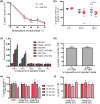The exported chaperone Hsp70-x supports virulence functions for Plasmodium falciparum blood stage parasites
- PMID: 28732045
- PMCID: PMC5521827
- DOI: 10.1371/journal.pone.0181656
The exported chaperone Hsp70-x supports virulence functions for Plasmodium falciparum blood stage parasites
Abstract
Malaria is caused by five different Plasmodium spp. in humans each of which modifies the host erythrocyte to survive and replicate. The two main causes of malaria, P. falciparum and P. vivax, differ in their ability to cause severe disease, mainly due to differences in the cytoadhesion of infected erythrocytes (IE) in the microvasculature. Cytoadhesion of P. falciparum in the brain leads to a large number of deaths each year and is a consequence of exported parasite proteins, some of which modify the erythrocyte cytoskeleton while others such as PfEMP1 project onto the erythrocyte surface where they bind to endothelial cells. Here we investigate the effects of knocking out an exported Hsp70-type chaperone termed Hsp70-x that is present in P. falciparum but not P. vivax. Although the growth of Δhsp70-x parasites was unaffected, the export of PfEMP1 cytoadherence proteins was delayed and Δhsp70-x IE had reduced adhesion. The Δhsp70-x IE were also more rigid than wild-type controls indicating changes in the way the parasites modified their host erythrocyte. To investigate the cause of this, transcriptional and translational changes in exported and chaperone proteins were monitored and some changes were observed. We propose that PfHsp70-x is not essential for survival in vitro, but may be required for the efficient export and functioning of some P. falciparum exported proteins.
Conflict of interest statement
Figures






Similar articles
-
Cholesterol bound Plasmodium falciparum co-chaperone 'PFA0660w' complexes with major virulence factor 'PfEMP1' via chaperone 'PfHsp70-x'.Sci Rep. 2019 Feb 25;9(1):2664. doi: 10.1038/s41598-019-39217-y. Sci Rep. 2019. PMID: 30804381 Free PMC article.
-
The Plasmodium falciparum Hsp70-x chaperone assists the heat stress response of the malaria parasite.FASEB J. 2019 Dec;33(12):14611-14624. doi: 10.1096/fj.201901741R. Epub 2019 Nov 14. FASEB J. 2019. PMID: 31690116 Free PMC article.
-
The Malarial Exported PFA0660w Is an Hsp40 Co-Chaperone of PfHsp70-x.PLoS One. 2016 Feb 4;11(2):e0148517. doi: 10.1371/journal.pone.0148517. eCollection 2016. PLoS One. 2016. PMID: 26845441 Free PMC article.
-
The role of PfEMP1 adhesion domain classification in Plasmodium falciparum pathogenesis research.Mol Biochem Parasitol. 2014 Jul;195(2):82-7. doi: 10.1016/j.molbiopara.2014.07.006. Epub 2014 Jul 23. Mol Biochem Parasitol. 2014. PMID: 25064606 Free PMC article. Review.
-
Malaria's deadly grip: cytoadhesion of Plasmodium falciparum-infected erythrocytes.Cell Microbiol. 2013 Dec;15(12):1976-83. doi: 10.1111/cmi.12183. Epub 2013 Sep 4. Cell Microbiol. 2013. PMID: 23957661 Free PMC article. Review.
Cited by
-
Role of Heat Shock Proteins in Immune Modulation in Malaria.Adv Exp Med Biol. 2021;1340:169-186. doi: 10.1007/978-3-030-78397-6_7. Adv Exp Med Biol. 2021. PMID: 34569025
-
Human granzyme B binds Plasmodium falciparum Hsp70-x and mediates antiplasmodial activity in vitro.Cell Stress Chaperones. 2023 May;28(3):321-331. doi: 10.1007/s12192-023-01339-8. Epub 2023 Apr 19. Cell Stress Chaperones. 2023. PMID: 37074531 Free PMC article.
-
Exported plasmodial J domain protein, PFE0055c, and PfHsp70-x form a specific co-chaperone-chaperone partnership.Cell Stress Chaperones. 2021 Mar;26(2):355-366. doi: 10.1007/s12192-020-01181-2. Epub 2020 Nov 24. Cell Stress Chaperones. 2021. PMID: 33236291 Free PMC article.
-
Comparative structure-function features of Hsp70s of Plasmodium falciparum and human origins.Biophys Rev. 2019 Jun 8;11(4):591-602. doi: 10.1007/s12551-019-00563-w. Epub 2019 Jul 6. Biophys Rev. 2019. PMID: 31280465 Free PMC article. Review.
-
Plasmodium falciparum Molecular Chaperones: Guardians of the Malaria Parasite Proteome and Renovators of the Host Proteome.Front Cell Dev Biol. 2022 May 16;10:921739. doi: 10.3389/fcell.2022.921739. eCollection 2022. Front Cell Dev Biol. 2022. PMID: 35652103 Free PMC article. Review.
References
-
- World Malaria Report [Internet]. 2016.
-
- Newbold C, Craig A, Kyes S, Rowe A, Fernandez-Reyes D, Fagan T. Cytoadherence, pathogenesis and the infected red cell surface in Plasmodium falciparum. Int J Parasitol. 1999;29(6):927–37. . - PubMed
-
- Rogerson SJ, Hviid L, Duffy PE, Leke RF, Taylor DW. Malaria in pregnancy: pathogenesis and immunity. Lancet Infect Dis. 2007;7(2):105–17. doi: 10.1016/S1473-3099(07)70022-1 . - DOI - PubMed
-
- Umbers AJ, Aitken EH, Rogerson SJ. Malaria in pregnancy: small babies, big problem. Trends Parasitol. 2011;27(4):168–75. doi: 10.1016/j.pt.2011.01.007 . - DOI - PubMed
-
- Maier AG, Rug M, O'Neill MT, Brown M, Chakravorty S, Szestak T, et al. Exported Proteins Required for Virulence and Rigidity of Plasmodium falciparum-Infected Human Erythrocytes. Cell. 2008;134(1):48–61. doi: 10.1016/j.cell.2008.04.051 - DOI - PMC - PubMed
MeSH terms
Substances
LinkOut - more resources
Full Text Sources
Other Literature Sources
Miscellaneous

